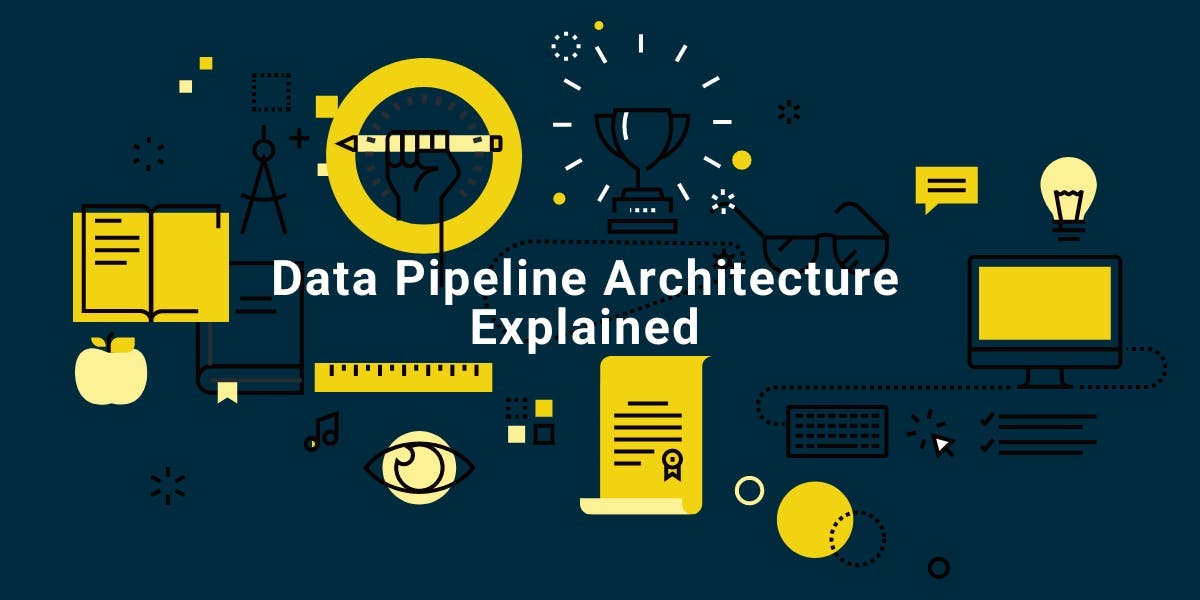Data Pipeline Architecture Explained
Flipnode on Apr 28 2023

Properly managing the flow of raw data within your company is crucial to ensure successful transfer from source to destination. Failure to do so can lead to errors, duplicates, or data damage, especially with the ever-increasing amount of online data sources that further complicate extraction.
To address these challenges, a data pipeline architecture can be built to ensure consistency and reliability of information, while eliminating manual data extraction work. In this article, we'll explore what a data pipeline architecture is and provide insights on how to build a robust one for your team.
What is a data pipeline architecture?
In order to comprehend its structure, let's take a closer look at the data pipeline as a unified entity. Essentially, a data pipeline serves as a means of transferring data from its source to its target system. However, with an increasing number of distinct data sources, a more sophisticated solution is necessary, which is where the data pipeline architecture comes into play.
In essence, the data pipeline architecture is a system that gathers, organizes, and delivers online data. It consists of various components such as data sources, processing systems, analytical tools, and storage units that are interconnected. Due to the fact that raw data often contain irrelevant material, it can be challenging to utilize it for business analytics and intelligence. A data pipeline architecture arranges this data in a way that facilitates its analysis, storage, and extraction of insights.
Why is data pipeline important?
As mentioned earlier, the ever-increasing amount of online data necessitates the use of large data pipelines. But why is this system so crucial?
- Readily accessible for various teams: The data pipeline architecture enables businesses to handle data in real time, analyze it, create reports, and gain insights. A sophisticated infrastructure can deliver the required data, in the right format, to the right person.
- Multiple sources in one place: The data pipeline architecture consolidates information from numerous sources, filters, and delivers only the necessary data. This eliminates the need to obtain data separately or be overwhelmed with irrelevant information.
- Streamlined transfer process: A robust data pipeline architecture enables businesses to seamlessly transfer data from one system to another. Typically, when transferring data between systems, it is necessary to move it from one data warehouse to another, change formats, or integrate it with other sources. With a data pipeline, it is possible to unify data components and create a system that works seamlessly.
- Improved security: Finally, a data pipeline architecture helps businesses restrict access to sensitive information. For example, they can adjust the settings so that only specific teams can access certain data.
Main components of a data pipeline
The purpose of a data pipeline is to transfer data from its source to a data warehouse while also organizing and transforming it. In this section, we will examine each architectural element and its function.
- In data pipeline architecture, the origin serves as the entry point for all data sources. Common origin types include application APIs, processing applications, and data storage systems like data warehouses.
- Dataflow refers to the process of transferring data from the origin to the final destination. The most commonly used dataflow approach is ETL (Extract, Transform, Load) pipeline.
- Extract involves acquiring data from sources such as SQL or NoSQL databases, XML files, or cloud platforms that hold data for marketing tools, CRM, or transactional systems.
- Transform involves converting data into a format that is suitable for the target system.
- Load involves placing the transformed data into the target system, which could be a database or cloud data warehouse such as Google BigQuery, Snowflake, or Amazon RedShift.
- The destination is the final point where the data is moved, which is typically a data warehouse or data analysis/business intelligence tool.
- Monitoring is the process of routinely tracking the pipeline's performance to ensure that it is working correctly and completing all required tasks.
What are the most common data pipeline technologies?
When it comes to building a data pipeline, businesses have two options: using a third-party SaaS (software as a service) or developing their own solution. If they choose the latter, they'll need a team of developers to write, test, and maintain the code for the pipeline.
To build a data pipeline, developers typically use a variety of tools and technologies. Some of the most common ones include:
Amazon Web Services (AWS): a cloud computing platform that provides APIs and storage options like Simple Storage Service (S3) and Elastic Block Store (EBS). AWS also offers Amazon Relational Database Service for performance optimization of transactional workloads.
Kafka: a distributed event store and stream-processing platform designed for building robust data pipelines, integration, and streaming analytics applications. Kafka Connect and Kafka Streams components facilitate the integration of messages, data, and storage, while SQL commands allow for filtering, transforming, and aggregating data streams for continuous processing with ksqlDB.
Hadoop: a framework that allows you to store and process large datasets in an open source environment. It's particularly suitable for processing already-distributed datasets across multiple servers and machines. To achieve this, Hadoop utilizes the MapReduce framework and Yarn technology to break down tasks and quickly respond to queries.
Striim: a platform for data integration and intelligence that's both intuitive and easy to implement. It enables streaming analytics and data transformations and features an alert system, agent-based approach, data migration protection, and data recovery in case of any issues.
Spark: a unified analytics engine that processes large-scale data, and it's available as an open-source tool. It lets you merge historical and streaming data and supports multiple programming languages, including Java, Python, and Scala. Additionally, Spark provides access to multiple Apache Spark components.
Data pipeline architecture examples
To gain a better understanding of how a data pipeline architecture operates, let's examine a few examples. There are three typical types of data pipeline architecture: Batch-based, Streaming, and Lambda. The main distinction among these examples is how the data is processed.
In the Batch-based Architecture, data is processed in batches at regular intervals. For instance, if you have a customer service platform that holds a large amount of customer data that needs to be sent to an analytics tool, the data entries will be split into separate batches and sent to the analytics tool batch by batch.
In the Streaming Architecture, data is processed unit by unit as soon as it is received from the origin, unlike the Batch-based architecture, where it is handled periodically in bundles.
The Lambda Architecture combines the Batch-based and Streaming approaches, resulting in a complex system where data is processed periodically as batches, as well as in whole units. This sophisticated architecture enables the analysis of both historical and real-time data.
Conclusion
By transferring, altering, and retaining datasets, data pipelines empower businesses to acquire critical insights. However, with the continuously increasing volume of online data, data pipelines necessitate resilience and complexity to ensure seamless operation.



